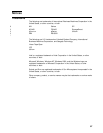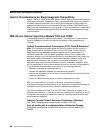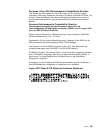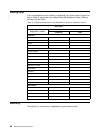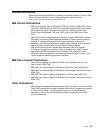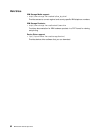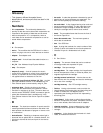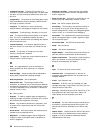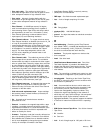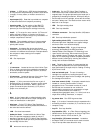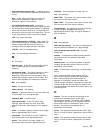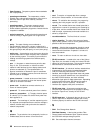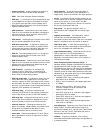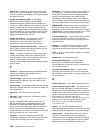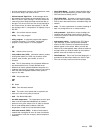command time-out. Following the issuance of a
command, a period of time during which it is determined
that there is a bad connection between the server and
the drive.
compression. The process of eliminating gaps, empty
fields, redundancies, and unnecessary data to shorten
the length of records or blocks.
configure. To describe to a server the devices,
optional features, and programs installed on the system.
contiguous. Touching along a boundary or at a point.
core. The light-conducting central portion of an optical
fiber. The core is composed of material that has a
higher index of refraction than the cladding (the material
that surrounds the core).
counterclockwise. In a direction opposite to that in
which the hands of a clock rotate, as viewed from the
front.
current. The quantity of charge per unit of time.
Current is measured in amperes.
cycle power. To apply and remove electrical power to
a device within a short time span.
D
data. Any representations such as characters or
analog quantities to which meaning is, or might be,
assigned.
data cartridge. A tape cartridge that is dedicated to
storing data. Contrast with cleaning cartridge.
data compression. See compression.
data transfer rate. The average number of bits,
characters, or blocks per unit of time that pass between
corresponding equipment in a data transmission system.
The rate is expressed in bits, characters, or blocks per
second, minute, or hour.
dc. Direct current.
degauss. To make a magnetic tape nonmagnetic by
exposing the tape to electrical coils which carry currents
that neutralize the magnetism of the tape.
device. Any hardware component or peripheral, such
as a tape drive or tape library, that can receive and
send data.
device driver. A file that contains the firmware that is
needed to use an attached device.
diagnostic. A software program that is designed to
recognize, locate, and explain faults in equipment or
errors in programs.
diagnostic cartridge. A tape cartridge that enables
the detection and isolation of errors in programs and
faults in equipment.
direct current (dc). An electric current flowing in one
direction only and substantially constant in value.
drive. See Ultrium Internal Tape Drive.
drive dump. The recording, at a particular instant, of
the contents of all or part of one storage device into
another storage device, usually as a safeguard against
faults or errors, or in connection with debugging.
drive head. The component that records an electrical
signal onto magnetic tape, or reads a signal from tape
into an electrical signal.
drive sense data. See SCSI drive sense data.
dump. See drive dump.
duplex. See duplex transmission.
duplex adapter. A mechanism that allows a device to
send and receive communication at the same time.
duplex transmission. Transmission in both directions,
either one direction at a time (half-duplex) or both
directions simultaneously (full-duplex).
E
eject. To remove or force out from within.
electronic mail. Correspondence in the form of
messages transmitted between user terminals over a
computer network.
e-mail. See electronic mail.
enclosure. A device, such as a desktop unit, tape
cartridge autoloader, or tape library, into which you can
install the Ultrium Tape Drive.
error log. Maintained by the Ultrium Tape Drive, a list
that contains the ten most recent error codes. The
codes identify errors that pertain to the drive.
F
fan shroud. The wire mesh enclosure around the fan
that holds it in place and prevents direct access. The
shroud mounts the fan assembly to the Ultrium Tape
Drive.
feature switch. Located under the Ultrium Tape Drive,
a bank of eight micro switches that can be manually
toggled on or off to activate or deactivate different
characteristics of the drive.
94 IBM Ultrium Internal Tape Drive
|
|
|
|
|
|
|
|
|
|
|
|
|
|
|
|
|
|
|
|
|
|
|
|
|
|
|
|
|
|
|
|
|
|
|
|
|
|
|
|
|
|
|
|
|
|
|
|
|
|
|
|
|
|
|
|
|
|
|
|
|
|
|
|
|
|
|
|
|
|
|
|
|
|
|
|
|
|
|
|
|
|
|
|
|
|
|




